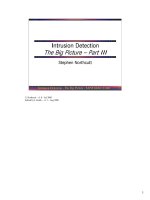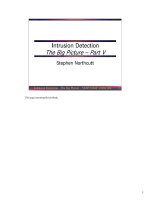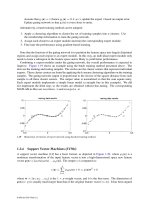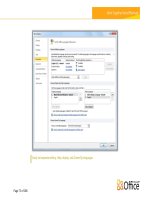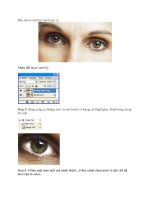Tài liệu Solution of Linear Algebraic Equations part 5 docx
Bạn đang xem bản rút gọn của tài liệu. Xem và tải ngay bản đầy đủ của tài liệu tại đây (169.88 KB, 6 trang )
50
Chapter 2. Solution of Linear Algebraic Equations
Sample page from NUMERICAL RECIPES IN C: THE ART OF SCIENTIFIC COMPUTING (ISBN 0-521-43108-5)
Copyright (C) 1988-1992 by Cambridge University Press.Programs Copyright (C) 1988-1992 by Numerical Recipes Software.
Permission is granted for internet users to make one paper copy for their own personal use. Further reproduction, or any copying of machine-
readable files (including this one) to any servercomputer, is strictly prohibited. To order Numerical Recipes books,diskettes, or CDROMs
visit website or call 1-800-872-7423 (North America only),or send email to (outside North America).
A quick-and-dirty way to solve complex systems is to take the real and imaginary
parts of (2.3.16), giving
A · x − C · y = b
C · x + A · y = d
(2.3.17)
which can be written as a 2N × 2N set of real equations,
A −C
CA
·
x
y
=
b
d
(2.3.18)
and then solved with ludcmp and lubksb in their present forms. This scheme is a factor of
2 inefficient in storage, since A and C are stored twice. It is also a factor of 2 inefficient in
time, since the complex multiplies in a complexified version of the routines would each use
4 real multiplies, while the solution of a 2N × 2N problem involves 8 times the work of
an N × N one. If you can tolerate these factor-of-two inefficiencies, then equation (2.3.18)
is an easy way to proceed.
CITED REFERENCES AND FURTHER READING:
Golub, G.H., and Van Loan, C.F. 1989,
Matrix Computations
, 2nd ed. (Baltimore: Johns Hopkins
University Press), Chapter 4.
Dongarra, J.J., et al. 1979,
LINPACK User’s Guide
(Philadelphia: S.I.A.M.).
Forsythe, G.E., Malcolm, M.A., and Moler, C.B. 1977,
Computer Methods for Mathematical
Computations
(Englewood Cliffs, NJ: Prentice-Hall),
§
3.3, and p. 50.
Forsythe, G.E., and Moler, C.B. 1967,
Computer Solution of Linear Algebraic Systems
(Engle-
wood Cliffs, NJ: Prentice-Hall), Chapters 9, 16, and 18.
Westlake, J.R. 1968,
A Handbook of Numerical Matrix Inversion and Solution of Linear Equations
(New York: Wiley).
Stoer, J., and Bulirsch, R. 1980,
Introduction to Numerical Analysis
(New York: Springer-Verlag),
§
4.2.
Ralston, A., and Rabinowitz, P. 1978,
A First Course in Numerical Analysis
, 2nd ed. (New York:
McGraw-Hill),
§
9.11.
Horn, R.A., and Johnson, C.R. 1985,
Matrix Analysis
(Cambridge: Cambridge University Press).
2.4 Tridiagonal and Band Diagonal Systems
of Equations
The special case of a system of linear equations that is tridiagonal, that is, has
nonzero elements only on the diagonal plus or minus one column, is one that occurs
frequently. Also common are systems that are band diagonal,withnonzero elements
only along a few diagonal lines adjacent to the main diagonal (above and below).
For tridiagonal sets, the procedures of LU decomposition, forward- and back-
substitutioneach take only O(N ) operations, and the whole solution can be encoded
very concisely. The resulting routine tridag is one that we will use in later chapters.
Naturally, one does not reserve storage for the full N × N matrix, but only for
the nonzero components, stored as three vectors. The set of equations to be solved is
b
1
c
1
0 ···
a
2
b
2
c
2
···
···
··· a
N−1
b
N−1
c
N−1
··· 0 a
N
b
N
·
u
1
u
2
···
u
N−1
u
N
=
r
1
r
2
···
r
N−1
r
N
(2.4.1)
2.4 Tridiagonal and Band Diagonal Systems of Equations
51
Sample page from NUMERICAL RECIPES IN C: THE ART OF SCIENTIFIC COMPUTING (ISBN 0-521-43108-5)
Copyright (C) 1988-1992 by Cambridge University Press.Programs Copyright (C) 1988-1992 by Numerical Recipes Software.
Permission is granted for internet users to make one paper copy for their own personal use. Further reproduction, or any copying of machine-
readable files (including this one) to any servercomputer, is strictly prohibited. To order Numerical Recipes books,diskettes, or CDROMs
visit website or call 1-800-872-7423 (North America only),or send email to (outside North America).
Noticethat a
1
and c
N
areundefined and are notreferenced by the routinethat follows.
#include "nrutil.h"
void tridag(float a[], float b[], float c[], float r[], float u[],
unsigned long n)
Solves for a vector
u[1..n]
the tridiagonal linear set given by equation (2.4.1).
a[1..n]
,
b[1..n]
,
c[1..n]
,and
r[1..n]
are input vectors and are not modified.
{
unsigned long j;
float bet,*gam;
gam=vector(1,n); One vector of workspace, gam is needed.
if (b[1] == 0.0) nrerror("Error 1 in tridag");
If this happens then you should rewrite your equations as a set of order N − 1,withu
2
trivially eliminated.
u[1]=r[1]/(bet=b[1]);
for (j=2;j<=n;j++) { Decomposition and forward substitution.
gam[j]=c[j-1]/bet;
bet=b[j]-a[j]*gam[j];
if (bet == 0.0) nrerror("Error 2 in tridag"); Algorithm fails; see be-
low.u[j]=(r[j]-a[j]*u[j-1])/bet;
}
for (j=(n-1);j>=1;j--)
u[j] -= gam[j+1]*u[j+1]; Backsubstitution.
free_vector(gam,1,n);
}
There is no pivoting in tridag. It is for this reason that tridag can fail even
when the underlyingmatrix is nonsingular: A zero pivot can be encountered even for
a nonsingularmatrix. In practice, this is not something to lose sleep about. The kinds
of problems that lead to tridiagonal linear sets usually have additional properties
which guarantee that the algorithm in tridag will succeed. For example, if
|b
j
| > |a
j
| + |c
j
| j =1,...,N (2.4.2)
(called diagonal dominance)thenitcan be shown that the algorithmcannot encounter
a zero pivot.
It is possible to construct special examples in which the lack of pivoting in the
algorithmcausesnumerical instability. In practice, however, such instability isalmost
never encountered — unlike the general matrix problem where pivotingis essential.
The tridiagonal algorithm is the rare case of an algorithm that, in practice, is
more robust than theory says it should be. Of course, should you ever encounter a
problem for which tridag fails, you can instead use the more general method for
band diagonal systems, now described (routines bandec and banbks).
Some other matrix forms consisting of tridiagonal with a small number of
additional elements (e.g., upper right and lower left corners) also allow rapid
solution; see §2.7.
Band Diagonal Systems
Where tridiagonal systems have nonzero elements only on the diagonal plus or minus
one, banddiagonalsystemsare slightly more generalandhave (say) m
1
≥ 0 nonzeroelements
immediately to the left of (below) the diagonal and m
2
≥ 0 nonzeroelements immediately to
its right (above it). Of course, this is only a useful classification if m
1
and m
2
are both N.
52
Chapter 2. Solution of Linear Algebraic Equations
Sample page from NUMERICAL RECIPES IN C: THE ART OF SCIENTIFIC COMPUTING (ISBN 0-521-43108-5)
Copyright (C) 1988-1992 by Cambridge University Press.Programs Copyright (C) 1988-1992 by Numerical Recipes Software.
Permission is granted for internet users to make one paper copy for their own personal use. Further reproduction, or any copying of machine-
readable files (including this one) to any servercomputer, is strictly prohibited. To order Numerical Recipes books,diskettes, or CDROMs
visit website or call 1-800-872-7423 (North America only),or send email to (outside North America).
In that case, the solution of the linear system by LU decomposition can be accomplished
much faster, and in much less storage, than for the general N × N case.
The precise definition of a band diagonal matrix with elements a
ij
is that
a
ij
=0 when j>i+m
2
or i>j+m
1
(2.4.3)
Band diagonalmatrices are stored and manipulated in a so-called compact form, which results
if the matrix is tilted 45
◦
clockwise, so that its nonzero elements lie in a long, narrow
matrix with m
1
+1+m
2
columns and N rows. This is best illustrated by an example:
The band diagonal matrix
3100000
4150000
9265000
0358900
0079320
0003846
0000244
(2.4.4)
which has N =7,m
1
=2,andm
2
=1, is stored compactly as the 7 × 4 matrix,
xx31
x415
9265
3589
7932
3846
244x
(2.4.5)
Here x denotes elements that are wasted space in the compact format; these will not be
referenced by any manipulations and can have arbitrary values. Notice that the diagonal
of the original matrix appears in column m
1
+1, with subdiagonal elements to its left,
superdiagonal elements to its right.
The simplest manipulation of a band diagonal matrix, stored compactly, is to multiply
it by a vector to its right. Although this is algorithmically trivial, you might want to study
the following routine carefully, as an example of how to pull nonzero elements a
ij
out of the
compact storage format in an orderly fashion.
#include "nrutil.h"
void banmul(float **a, unsigned long n, int m1, int m2, float x[], float b[])
Matrix multiply b = A · x,whereAis band diagonal with
m1
rows below the diagonal and
m2
rows above. The input vector x and output vector b are stored as
x[1..n]
and
b[1..n]
,
respectively. The array
a[1..n][1..m1+m2+1]
stores A as follows: The diagonal elements
are in
a[1..n][m1+1]
. Subdiagonal elements are in
a[
j
..n][1..m1]
(with j>1ap-
propriate to the number of elements on each subdiagonal). Superdiagonal elements are in
a[1..
j
][m1+2..m1+m2+1]
with j<
n
appropriate to the number of elements on each su-
perdiagonal.
{
unsigned long i,j,k,tmploop;
for (i=1;i<=n;i++) {
k=i-m1-1;
tmploop=LMIN(m1+m2+1,n-k);
b[i]=0.0;
for (j=LMAX(1,1-k);j<=tmploop;j++) b[i] += a[i][j]*x[j+k];
}
}
2.4 Tridiagonal and Band Diagonal Systems of Equations
53
Sample page from NUMERICAL RECIPES IN C: THE ART OF SCIENTIFIC COMPUTING (ISBN 0-521-43108-5)
Copyright (C) 1988-1992 by Cambridge University Press.Programs Copyright (C) 1988-1992 by Numerical Recipes Software.
Permission is granted for internet users to make one paper copy for their own personal use. Further reproduction, or any copying of machine-
readable files (including this one) to any servercomputer, is strictly prohibited. To order Numerical Recipes books,diskettes, or CDROMs
visit website or call 1-800-872-7423 (North America only),or send email to (outside North America).
It is not possible to store the LU decomposition of a band diagonal matrix A quite
as compactly as the compact form of A itself. The decomposition (essentially by Crout’s
method, see §2.3) producesadditional nonzero “fill-ins.” One straightforward storage scheme
is to return the upper triangular factor (U) in the same space that A previously occupied, and
to return the lower triangular factor (L) in a separate compact matrix of size N × m
1
.The
diagonal elements of U (whose product, times d = ±1, gives the determinant) are returned
in the first column of A’s storage space.
The following routine, bandec, is the band-diagonal analog of ludcmp in §2.3:
#include <math.h>
#define SWAP(a,b) {dum=(a);(a)=(b);(b)=dum;}
#define TINY 1.0e-20
void bandec(float **a, unsigned long n, int m1, int m2, float **al,
unsigned long indx[], float *d)
Given an
n
×
n
band diagonal matrix A with
m1
subdiagonal rows and
m2
superdiagonal rows,
compactly stored in the array
a[1..n][1..m1+m2+1]
as described in the comment for routine
banmul
, this routine constructs an LU decomposition of a rowwise permutation of A. The upper
triangular matrix replaces
a
, while the lower triangular matrix is returned in
al[1..n][1..m1]
.
indx[1..n]
is an output vector which records the row permutation effected by the partial
pivoting;
d
is output as ±1 depending on whether the number of row interchanges was even
or odd, respectively. This routine is used in combination with
banbks
to solve band-diagonal
sets of equations.
{
unsigned long i,j,k,l;
int mm;
float dum;
mm=m1+m2+1;
l=m1;
for (i=1;i<=m1;i++) { Rearrange the storage a bit.
for (j=m1+2-i;j<=mm;j++) a[i][j-l]=a[i][j];
l--;
for (j=mm-l;j<=mm;j++) a[i][j]=0.0;
}
*d=1.0;
l=m1;
for (k=1;k<=n;k++) { For each row...
dum=a[k][1];
i=k;
if (l < n) l++;
for (j=k+1;j<=l;j++) { Find the pivot element.
if (fabs(a[j][1]) > fabs(dum)) {
dum=a[j][1];
i=j;
}
}
indx[k]=i;
if (dum == 0.0) a[k][1]=TINY;
Matrix is algorithmically singular, but proceed anyway with TINY pivot (desirable in
some applications).
if (i != k) { Interchange rows.
*d = -(*d);
for (j=1;j<=mm;j++) SWAP(a[k][j],a[i][j])
}
for (i=k+1;i<=l;i++) { Do the elimination.
dum=a[i][1]/a[k][1];
al[k][i-k]=dum;
for (j=2;j<=mm;j++) a[i][j-1]=a[i][j]-dum*a[k][j];
a[i][mm]=0.0;
}
}
}
54
Chapter 2. Solution of Linear Algebraic Equations
Sample page from NUMERICAL RECIPES IN C: THE ART OF SCIENTIFIC COMPUTING (ISBN 0-521-43108-5)
Copyright (C) 1988-1992 by Cambridge University Press.Programs Copyright (C) 1988-1992 by Numerical Recipes Software.
Permission is granted for internet users to make one paper copy for their own personal use. Further reproduction, or any copying of machine-
readable files (including this one) to any servercomputer, is strictly prohibited. To order Numerical Recipes books,diskettes, or CDROMs
visit website or call 1-800-872-7423 (North America only),or send email to (outside North America).
Some pivoting is possible within the storage limitations of bandec, and the above
routine does take advantage of the opportunity. In general, when TINY is returned as a
diagonal element of U, then the original matrix (perhaps as modified by roundoff error)
is in fact singular. In this regard, bandec is somewhat more robust than tridag above,
which can fail algorithmically even for nonsingular matrices; bandec is thus also useful (with
m
1
= m
2
=1) for some ill-behaved tridiagonal systems.
Oncethe matrix Ahas beendecomposed,anynumberofright-handsidescanbe solvedin
turn by repeated calls to banbks, the backsubstitutionroutine whose analog in §2.3 is lubksb.
#define SWAP(a,b) {dum=(a);(a)=(b);(b)=dum;}
void banbks(float **a, unsigned long n, int m1, int m2, float **al,
unsigned long indx[], float b[])
Given the arrays
a
,
al
,and
indx
as returned from
bandec
, and given a right-hand side vector
b[1..n]
, solves the band diagonal linear equations A · x = b. The solution vector x overwrites
b[1..n]
. The other input arrays are not modified, and can be left in place for successive calls
with different right-hand sides.
{
unsigned long i,k,l;
int mm;
float dum;
mm=m1+m2+1;
l=m1;
for (k=1;k<=n;k++) { Forward substitution, unscrambling the permuted rows
as we go.i=indx[k];
if (i != k) SWAP(b[k],b[i])
if (l < n) l++;
for (i=k+1;i<=l;i++) b[i] -= al[k][i-k]*b[k];
}
l=1;
for (i=n;i>=1;i--) { Backsubstitution.
dum=b[i];
for (k=2;k<=l;k++) dum -= a[i][k]*b[k+i-1];
b[i]=dum/a[i][1];
if (l < mm) l++;
}
}
The routines bandec and banbks are based on the Handbook routines bandet1 and
bansol1 in
[1]
.
CITED REFERENCES AND FURTHER READING:
Keller, H.B. 1968,
Numerical Methods for Two-Point Boundary-Value Problems
(Waltham, MA:
Blaisdell), p. 74.
Dahlquist, G., and Bjorck, A. 1974,
Numerical Methods
(Englewood Cliffs, NJ: Prentice-Hall),
Example 5.4.3, p. 166.
Ralston, A., and Rabinowitz, P. 1978,
A First Course in Numerical Analysis
, 2nd ed. (New York:
McGraw-Hill),
§
9.11.
Wilkinson, J.H., and Reinsch, C. 1971,
Linear Algebra
,vol.IIof
Handbook for Automatic Com-
putation
(New York: Springer-Verlag), Chapter I/6. [1]
Golub, G.H., and Van Loan, C.F. 1989,
Matrix Computations
, 2nd ed. (Baltimore: Johns Hopkins
University Press),
§
4.3.
